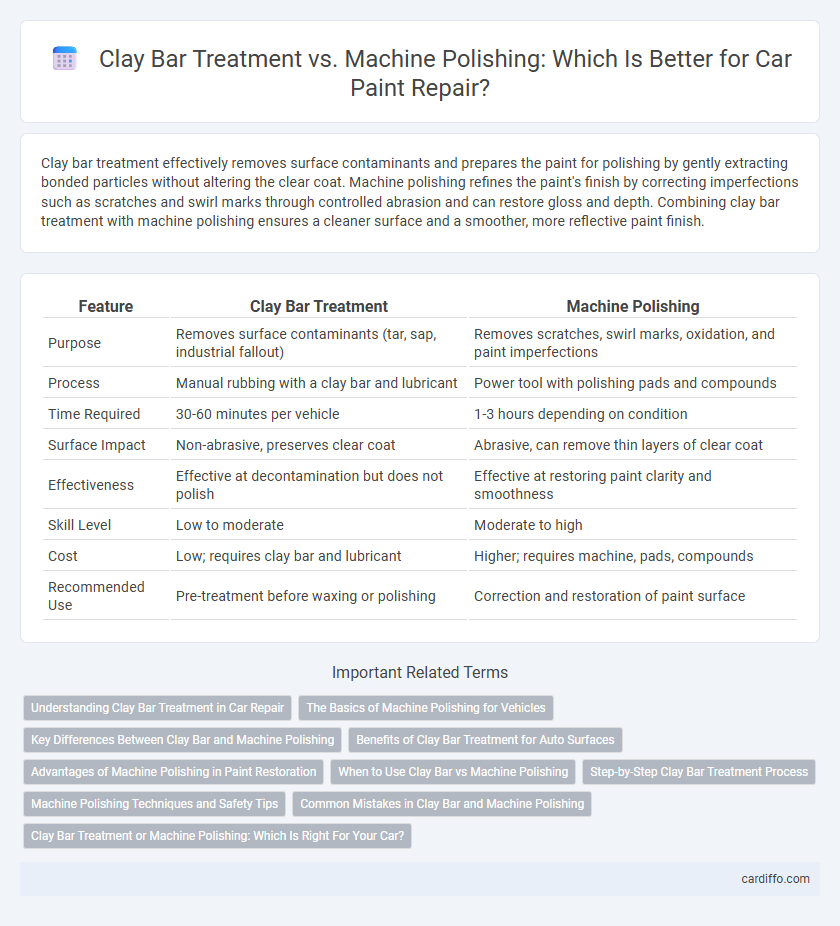Clay bar treatment effectively removes surface contaminants and prepares the paint for polishing by gently extracting bonded particles without altering the clear coat. Machine polishing refines the paint's finish by correcting imperfections such as scratches and swirl marks through controlled abrasion and can restore gloss and depth. Combining clay bar treatment with machine polishing ensures a cleaner surface and a smoother, more reflective paint finish.
Table of Comparison
| Feature | Clay Bar Treatment | Machine Polishing |
|---|---|---|
| Purpose | Removes surface contaminants (tar, sap, industrial fallout) | Removes scratches, swirl marks, oxidation, and paint imperfections |
| Process | Manual rubbing with a clay bar and lubricant | Power tool with polishing pads and compounds |
| Time Required | 30-60 minutes per vehicle | 1-3 hours depending on condition |
| Surface Impact | Non-abrasive, preserves clear coat | Abrasive, can remove thin layers of clear coat |
| Effectiveness | Effective at decontamination but does not polish | Effective at restoring paint clarity and smoothness |
| Skill Level | Low to moderate | Moderate to high |
| Cost | Low; requires clay bar and lubricant | Higher; requires machine, pads, compounds |
| Recommended Use | Pre-treatment before waxing or polishing | Correction and restoration of paint surface |
Understanding Clay Bar Treatment in Car Repair
Clay bar treatment in car repair effectively removes bonded contaminants such as tar, industrial fallout, and brake dust from the paint surface, ensuring a smoother finish before further detailing. Unlike machine polishing, which abrasively refines the paint to correct imperfections, clay bar treatment is a non-abrasive method crucial for paint decontamination. This process enhances the adhesion and effectiveness of subsequent polishing or waxing treatments, preserving the vehicle's clear coat integrity.
The Basics of Machine Polishing for Vehicles
Machine polishing for vehicles involves using a motorized tool with polishing pads and compounds to remove paint imperfections, oxidation, and swirl marks, restoring the car's gloss and smoothness effectively. Unlike clay bar treatment, which primarily removes surface contaminants, machine polishing physically refines and levels the paint surface to enhance clarity and depth of the finish. Mastery of speed, pressure, and pad selection is crucial for achieving professional results while preventing paint damage during the machine polishing process.
Key Differences Between Clay Bar and Machine Polishing
Clay bar treatment removes surface contaminants such as industrial fallout, tree sap, and overspray that washing cannot eliminate, creating a smooth base for further detailing. Machine polishing uses abrasive pads and compounds to correct paint imperfections like swirl marks, scratches, and oxidation, restoring gloss and depth. While clay bar focuses on decontamination, machine polishing targets paint correction and enhancement, making both essential but distinct steps in automotive paint care.
Benefits of Clay Bar Treatment for Auto Surfaces
Clay bar treatment effectively removes embedded contaminants like tar, sap, and industrial fallout that machine polishing may not fully eliminate. It restores a smooth, clean surface, enhancing paint adhesion and allowing subsequent wax or sealant applications to last longer. This process minimizes the risk of clear coat damage by offering a gentle yet thorough cleaning solution compared to the abrasive nature of machine polishing.
Advantages of Machine Polishing in Paint Restoration
Machine polishing offers superior precision in paint restoration by effectively removing deeper scratches, oxidation, and swirl marks that clay bar treatment cannot address. It enhances paint gloss and smoothness through controlled abrasion, providing a more uniform and long-lasting finish. Unlike clay bar treatment, machine polishing also increases paint adhesion for subsequent protective coatings, ensuring better durability.
When to Use Clay Bar vs Machine Polishing
Clay bar treatment is ideal for removing surface contaminants like overspray, tar, and industrial fallout that cannot be eliminated by washing alone. Machine polishing is best suited for correcting paint imperfections such as swirl marks, scratches, and oxidation by physically refining the clear coat. Use a clay bar before machine polishing to ensure a clean surface for optimal polishing results and prevent damage to the paint.
Step-by-Step Clay Bar Treatment Process
Clay bar treatment involves a step-by-step process starting with washing the vehicle thoroughly to remove loose dirt and contaminants. Next, the surface is lubricated with a clay bar lubricant or quick detailer to prevent scratching, followed by gently gliding the clay bar over the paint to lift embedded impurities. This method prepares the surface for polishing or waxing by restoring smoothness and enhancing paint clarity without aggressive abrasion.
Machine Polishing Techniques and Safety Tips
Machine polishing techniques involve using rotary or dual-action polishers with appropriate abrasive compounds to remove surface imperfections and restore paint clarity effectively. Ensuring safety requires wearing protective gear, maintaining consistent pressure and speed to avoid paint burning, and selecting the correct pad and polish combination for the vehicle's paint type. Proper machine polishing extends the longevity of clear coats while enhancing the overall finish more efficiently than manual clay bar treatments.
Common Mistakes in Clay Bar and Machine Polishing
Common mistakes in clay bar treatment include excessive force that can cause surface scratches and insufficient lubrication leading to paint damage. Machine polishing errors often involve using incorrect pad speeds or pressure, resulting in swirl marks or clear coat burns. Proper technique and understanding product specifications are essential to avoid compromising the vehicle's paint integrity during these detailing processes.
Clay Bar Treatment or Machine Polishing: Which Is Right For Your Car?
Clay bar treatment effectively removes surface contaminants like tar, brake dust, and industrial fallout, restoring a smooth finish without stripping paint. Machine polishing uses abrasives to eliminate deeper imperfections such as swirl marks, oxidation, and light scratches, enhancing paint depth and gloss. Choosing between clay bar treatment or machine polishing depends on your car's condition; clay bar is ideal for routine decontamination, while machine polishing suits more intensive correction and paint rejuvenation.
Clay bar treatment vs machine polishing Infographic

 cardiffo.com
cardiffo.com